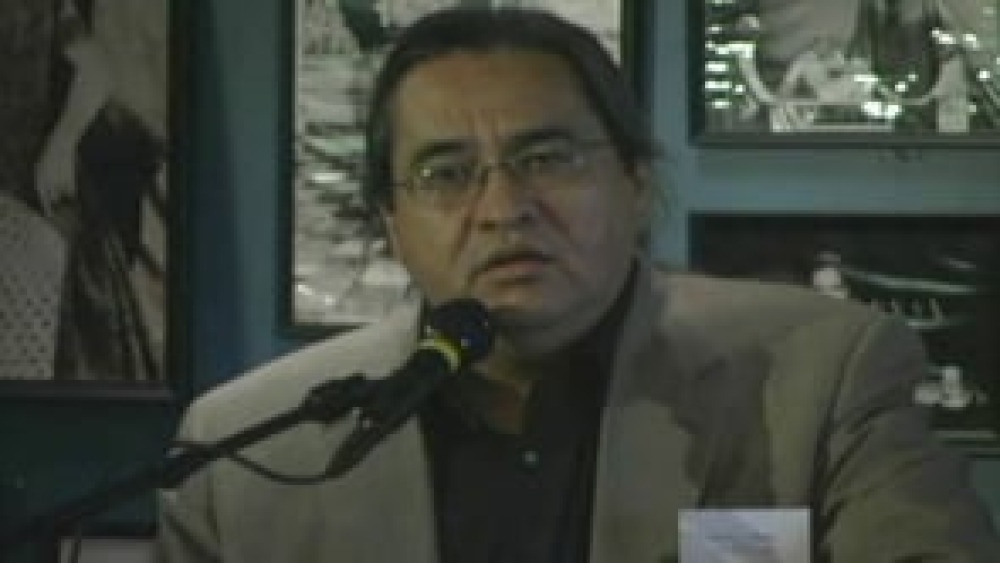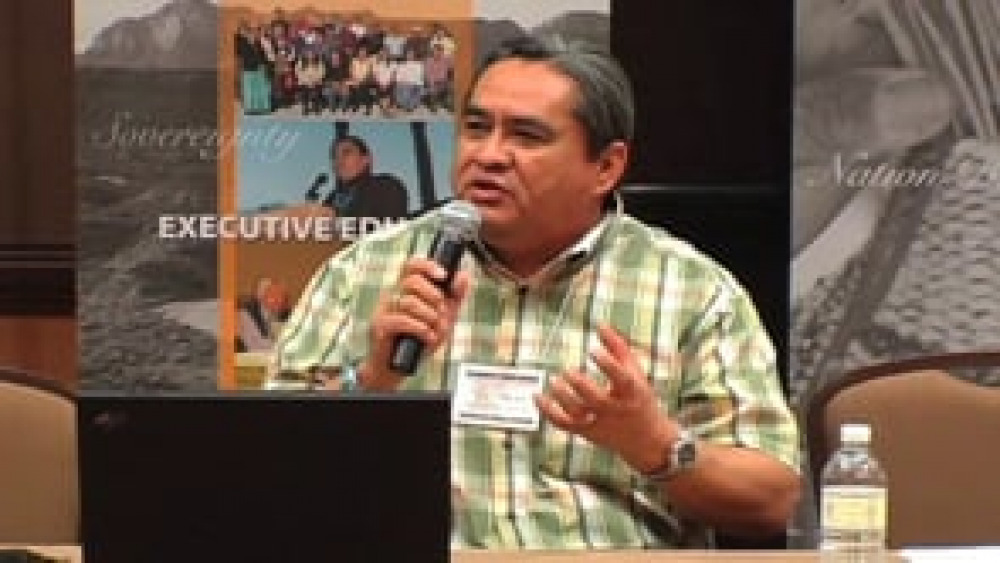Harvard Project on American Development Co-Director Manley A. Begay, Jr. synthesizes the learning that took place during the first day of the 2004 Honoring Nations symposium, focusing on the nation-building success stories chronicled during the day as testaments to and reflections of Indigenous self-determination.
Additional Information
Begay, Jr., Manley A. "Reflections on the Day." Honoring Nations symposium. Harvard Project on American Indian Economic Development, John F. Kennedy School of Government, Harvard University. Cambridge, Massachusetts. September 11, 2004. Presentation.
Transcript
"Thank you for the introduction and for sharing today with me. As I think about today, it's been a very good day. A lot of good discussions, good thoughts being expressed, and old friendships renewed and new friendships made. And all in all it's been a very good day. And as Amy mentioned, I am Navajo. I come from Tuba City by way of Wheatfields. Wheatfields is north of Window Rock about 50 miles. And my clans are Maii deeshgiizhinii -- that's my clan, Coyote Pass Clan. And I'm born for Tachiinii, the Red-Running-Into-the-Water People. And my maternal grandfather is Lokaa Dine'e, the Reed People. And my paternal grandfather is Todichiinii, Bitter Water People. So that's who I am as a Navajo person. And up to the year 2000, I had the great pleasure and honor of working with Joe Kalt here at Harvard. And since then, I've been stationed at the University of Arizona in Tucson, where I serve as a senior lecturer for the American Indian Studies Program, and also serve as Director for the Native Nations Institute for Leadership, Management and Policy, and the Native Nations Institute is a sister organization to the Harvard Project. And since then I've been working with Stephen Cornell, who directs the Udall Center for Studies in Public Policy, the other partner in crime.
And Andrew Lee asked me to talk a little bit about, before I begin to talk, a little bit about this particular logo. This logo is something that I began working on when Joe was really young. Now he's getting old and gray. And so this is sort of an art project I started working on. And when I finally came up with the design, a good friend John Thornier got together with me and he has the talent of working computers and the Mac program and all that, and he basically perfected this design. And this particular logo is really about power and strength. It's really about vision. It's really about unity and a sense of direction. And you can see that the eagle is in the center. And you know what the eagle means to many of us as Native people; it's the source of strength, it's a source of vision, and it's really sort of the centerpiece of the Harvard Project on American Indian Economic Development. And you'll see a number of feathers that go around, which represents Native nations throughout Indian country. And around that you'll see a hoop, and that hoop signifies unity and togetherness. And there's a sinew that wraps around that particular hoop. And sinew is really, I believe represents sovereignty, it really represents this sense of strength. The old ones would say that we should be like deer hide, fine deer hide, and that particular deer hide could be used for bows and arrows and it's very, very strong, yet at the same time it's flexible and it's soft and it can be tender. And so it really has these elements of both -- sort of strength, protection, yet at the same time one of tenderness and softness and flexibility. So that particular sinew wraps around that hoop and really signifies togetherness, strength, sovereignty. And that makes up this particular emblem. And obviously the four eagle feathers represents the four directions, the four winds.
You know, sitting here today and going into a few of the sessions, I've been asked to sort of reflect on this, this day. And, you know, I can't help but also recognize that I have relatives here and family members here as well, many of whom I respect highly. And it's really quite an honor also to be in their presence and to know that they are from not only Navajo country, but also from Indian Country at-large. At the Native Nations Institute at the University of Arizona, I share a joint duty with Joan Timeche. I'm not sure where Joan is at. She's probably at Harvard Square. No, Joan's back there. Joan and I run the show to the best of our abilities. And Joan comes from the Hopi Nation. And it is not true that Hopis and Navajos don't get along. We get along. I just follow what she says.
You know, not too long ago, we were being controlled by the federal government -- and Anthony Pico talks a bit about this -- and we were being controlled by the federal government through the Bureau of Indian Affairs. State governments and other entities also controlled us to a large extent. We were dictated to about how to govern and how to run programs and how to live. In our travels -- Joe Kalt, Steve Cornell and I -- we ran across a tribal chairman at one point in time that said, 'You know, I remember when, as a tribal chairman, before we could even make a decision I had to lean over to the BIA superintendent right next to me, get his permission before the council could vote.' Clearly somebody else was in power, not our own leaders. And this was occurring only a few years ago. It's not like it occurred decades and decades and decades ago. It just occurred recently.
Then things began to change at the urging, sometimes strongly, by the National Congress of American Indians, by the American Indian Movement, by the National Indian Youth Council, and many other organizations as strong leaders throughout Indian Country. And this really occurred on the heels of the Civil Rights Movement, movements that also included the Brown Berets, the Black Panthers and others. This was a time of change in the United States socially, and music began to change, people began to question, you know, 'Who are the Beatles, you know, who are the Rolling Stones, who's Bob Dylan?' And these were folks that were in the limelight. You know, peace and love were stressed amidst the Vietnam War. It was a time of upheaval for some. It was a time of needed change for others. For Native peoples, it was a time for needed change, a change from poverty and control, and we wanted to move toward a better life and freedom. And this same tribal chairman told us a short time later, 'You know, I found a bit of strength, and with this strength I told the BIA superintendent sitting next to me, 'Well, I really don't want you to sit by me anymore, I want you to move to the end of the table.' And so he moved to the end of the table.'
And I was just a young man at that time and, you know, somewhat in awe of the American Indian Movement. And their message was really a message of sovereignty at all costs. You know, I traveled at that time to Pine Ridge, to Flagstaff, Arizona to the [Childs?] Ranch, which is outside of Ajo, Arizona and protested the injustices that were occurring, the mistreatment that Indian people were going through. And these events were all part of the events like the BIA [Bureau of Indian Affairs] takeover in Washington, D.C., Wounded Knee II, the burning of the Custer Courthouse, and the taking over of the Richardson Trading Post in Gallup, New Mexico, and many other events like that. It began to change the tide of people's thinking. I even had the distinct pleasure and honor of going to Coachella Valley at one point in time and actually siding with Cesar Chavez and the United Farm Workers. What these events did was begin to change the mentality of many Native peoples from being subjugated to thinking more freely, to thinking about freedom. Remember, this is in the world's greatest nation. This is in the world's wealthiest nation. This is in the country that touts democracy and freedom as the pinnacle of civilization.
There really was a change from some outsiders deciding how we should live to the right to determine our own destinies. It was a change from the one-model-fits-all that was being perpetuated by the federal government to the right to think independently according to our own diverse cultural teachings, from an outsiders, making mistakes and not being accountable to less making our own mistakes and learning from them, from being told how we should govern to designing our own constitutions and governments. This same tribal chairman that had moved the BIA superintendent to the end of the table now was even more courageous. He said to us, he said, 'At times, you know, we're dealing with issues that we don't want the BIA to know about.' So he said, 'I finally told the BIA superintendent we don't really want you in here at this moment, so could you please leave?' And he left.
So you can see the change that occurred ever so slowly, but significant nevertheless. We are currently in the midst of a political resurgence. Finally, and over 500 years, we as Native peoples are in a position to determine our own futures with programs designed by us, not by an outside agency or person. It is in this context that we are seeing these Honoring Nation's programs. It is in this context we have wonderful uplifting stories from Lummi, Chickasaw, Menominee, Zuni, Chickaloon, Navajo, Tulalip, Gila River, Viejas. These stories are a long time coming. They are a testament to resilience of the human spirit, ushering in of justice against tremendous odds. They are a testament to the power of the human will. They are also a testament to the gifts of strength given to us by our elders, by the land, by the mountains, by the rivers, by fire, by rocks, by animals. Lastly, these programs are gifts to those yet unborn. These programs should be our gifts to those yet unborn. I look forward to the time with our young ones. Those yet unborn will say, 'I'm so glad my leaders developed those programs. My life is richer because of their wise decisions and sound management.'
I do, however, offer one word of caution. We should not become complacent with our successes. Vigilance is key, because our sovereignty is neither secure nor absolute, and poverty, poor housing, and other social ills are still with us. So the fight continues through assertion of sovereignty, with the building of culturally appropriate capable institutions of self-governance. And with good leadership may we all continue to remain strong and creative. May we continue to be vigilant in the things that we do. Thank you."


